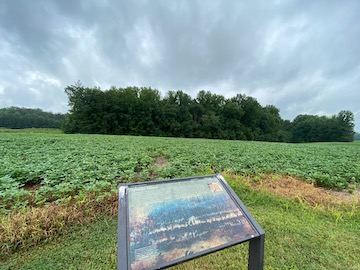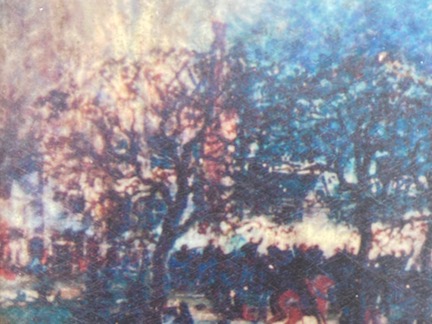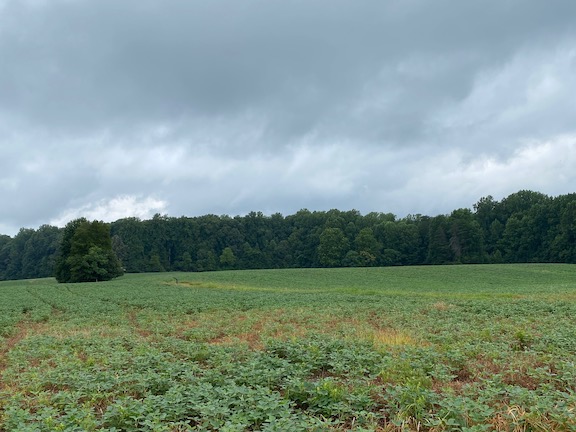In Search of Sarah Spindle
 Maxwell and I wind our way through a primordial tunnel of woods before the path we’re following descends a short staircase of plant roots and spits us out into a field. It’s an ersatz field, really—the Park Service hasn’t been able to mow or burn since before the pandemic, so this portion of Spindle Field is seriously close to rebelling back to nature. Sumac, oak trees, and spindly pines all fight above the tall grasses. Maxwell, four years old, seems like a field gnome skipping amongst the greenery.
Maxwell and I wind our way through a primordial tunnel of woods before the path we’re following descends a short staircase of plant roots and spits us out into a field. It’s an ersatz field, really—the Park Service hasn’t been able to mow or burn since before the pandemic, so this portion of Spindle Field is seriously close to rebelling back to nature. Sumac, oak trees, and spindly pines all fight above the tall grasses. Maxwell, four years old, seems like a field gnome skipping amongst the greenery.
It’s May 8, 2021, and we’re walking the trail from the Spotsylvania Exhibit Shelter out to Spindle Field. It’s the anniversary of the first day of the battle, and we’re walking in the footsteps of Peter Lyle’s brigade as it made the first Federal advance toward what it thought was yet another cavalry blockade—only to be disabused of that notion by the arrival of John Hennigan’s South Carolina infantry (formerly Kershaw’s Division).
But we’ve not come here to experience the woe of Lyle’s men. No, we’re here to remind ourselves of Sarah Spindle’s.
Sarah and her family lived on a farm often mistakenly referred to as Laurel Hill. “Laurel Hill” was actually a homestead three-quarters of a mile to the west owned by William Jones, but Union soldiers confused the names and the misnomer for the battle stuck. It seems the forgetting of Sarah Spindle began as soon as the soldiers arrived.
Of Sarah’s 312 acres, 200 were cultivated, usually with a mixture of wheat, corn, oats, hay, and even a little tobacco.[1] Those same open fields would provide sweeping access—and no cover—to the advancing Federal army.
At the heart of the farm sat the Sarah’s two-and-a-half story wood farmhouse, built in 1854. Several outbuildings surrounded it, all nestled on a ridge that extended perpendicularly from the nearby Brock Road.
It was down that road that Confederate cavalry had been slowly falling back all night, and it was the ridge on which Sarah’s house sat that invited the horsemen to try another stand on the property. Behind them another two miles was the village of Spotsylvania Court House—the objective of Ulysses S. Grant’s Federal forces—and the horsemen had spent all night desperately trying to slow Grant’s advance toward the village and its useful road network. Thus it was that war came to the Spindle family.
Sarah, listed in the 1860 census as head of household, had five people living under her roof, although their relationships aren’t entirely clear:
- William H. Spindle, 22
- Mary Spindle, 22
- Maria V. Spindle, 22
- Richard Spindle, 7
- Ella T. Spindle, 4
Sarah also owned 17 slaves; Mary owned two.
In July 1861, just ten days before the battle of First Manassas, William left the family to join Company B of the 30th Virginia infantry. On September 26 of that year, he transferred to Company E of the 9th Virginia Cavalry, a unit comprised of Spotsylvania County men.
That’s about all we know of Sarah and her family except, as legend has it, they were sitting down to breakfast when the war arrived on their farm. Col. Peter Lyle’s brigade came first, then Col. Andrew Denison’s. Then Brig. Gens. Joseph Bartlett and Romeyn Ayres and John C. Robinson, and finally Col. James L. Bates. Their V Corps commander, Maj. Gen. Gouverneur K. Warren, would take time to regroup before throwing more men across the field, twice more, later in the day.
All the while, Confederate cavalry commander Maj. Gen. Jeb Stuart rode along the line, directing newly arriving Confederate infantry into place. “Run for our rail piles,” Stuart called; “the Federal infantry will reach them first, if you don’t run.”[2] All the while, the cavalier looked “just as cool as a piece of ice, though all the time laughing,” said John Coxe of the 2nd South Carolina. Stuart, he noted, was “riding back and forth along our lines, cheering us with such words as ‘Give it to them, boys!’”[3]
When Coxe’s regiment was placed in line, the South Carolinian noted: “In the field directly in our front were a large two-story farmhouse and outbuildings.” It was the Spindle farm.
Coxe offers a vivid picture of the farmhouse caught between the armies:
A strong Federal line of battle developed in the woods back of the farm buildings, march up to them, and at once put into them a force of sharpshooters to annoy us. Up to this point, no artillery had been used by either side, but a moment later a Confederate battery of four Enfield guns and one brass howitzer, personally directed by Stuart, dashed up and, planting their guns at intervals along our line, opened a rapid fire in the advancing enemy, and this checked them near the farmhouses, behind which many of them crowded for refuge. Then Stuart ordered the artillery to burn the buildings, and the very first incendiary shell from the brass cannon fired the main building.
And then I saw a sight I never wanted to see again. A woman bareheaded, her long hair streaming behind, ran out of the big house and across the field to the left between the two fighting armies and reached shelter in the woods on the Po River.
Was this Sarah Spindle or some other woman in her household? What happened to the others? What happened to the enslaved people who once occupied the property?
The lone figure flees from the scene and, unfortunately, from history itself. We have no idea what happened to Sarah Spindle or the members of her family. Historian Robert K. Krick, in his history of the 9th Virginia Cavalry, provides a brief sketch of William:
Transferred to Co. E on 9/25/61, from Co. B, 30th Va. Inf. Absent sick, Nov. 1861 thru Feb. 1862. Discharged for disability (pneumonia), 4/23/62, age 28. Occupation ? merchant. Re?enlisted, 10/1/62. Promoted to Sgt., 12/20/62. Absent sick, May-Aug. 1863 and at 10/1/64 final roll.[4]
It is as, though, once the farmhouse caught afire, the entire Spindle story was scorched away. A member of the 84th New York (14th Brooklyn) noted the burning building when his regiment advanced as part of Warren’s midmorning assault. “It is said that this building was set on fire by an exploding shell while the family inside was at breakfast,” he wrote. “At any rate, the dwelling was burning fiercely when the Fourteenth arrived at the clearing, and here the fighting also became hot. Like hail the bullets spattered on the rail fences ling the road behind which the [regiment] took scant refuge. Besides those who had been struck by bullets, several were prostrated by the combined heat of the sun and the burning house.”[5]
 Maxwell and I follow the hiking path across Brock Road and along the ridge that leads to the former site of the Spindle farmhouse. He breaks out into a run now that we’re in an open field and can see where we’re going and we no longer have to worry about the road. The NPS has installed a wayside marker to mark the site. In 2004, an archeological dig found the remains of the house’s chimney, which have since been re-covered to protect them.
Maxwell and I follow the hiking path across Brock Road and along the ridge that leads to the former site of the Spindle farmhouse. He breaks out into a run now that we’re in an open field and can see where we’re going and we no longer have to worry about the road. The NPS has installed a wayside marker to mark the site. In 2004, an archeological dig found the remains of the house’s chimney, which have since been re-covered to protect them.
The ground on either side of the ridge rolls and bucks, so it’s not nearly the open, flat ascent it appears to be from the Federal perspective. The ridge adds a further layer of deception by hiding the fact that there’s another couple hundred yards of open field tucked on the far side. Federals hit that ridge and surely said “Oh crap” as they realized they had more exposed ground to cross even as they stood silhouetted on the ridge.
 Maxwell looks at the wayside, which features a painting of the burning house, obscured by trees. Conrad Freitag, the painter, was a German immigrant who served in the 84th New York and who was wounded at Spotsy. Freitag no doubt painted the inferno because his regiment was in such close proximity to it. Did he think of the home’s owners? Had he heard the story of the ill-fated breakfast? Had he seen anyone?
Maxwell looks at the wayside, which features a painting of the burning house, obscured by trees. Conrad Freitag, the painter, was a German immigrant who served in the 84th New York and who was wounded at Spotsy. Freitag no doubt painted the inferno because his regiment was in such close proximity to it. Did he think of the home’s owners? Had he heard the story of the ill-fated breakfast? Had he seen anyone?
The Spindle family and the enslaved people who lived on this ridge found themselves caught in the literal crossfire. They were among dozens of local families, free and enslaved, impacted by the arrival of war, caught between the lines, their lives uprooted and irrevocably changed. The Spotsylvania battlefield is dotted with such families and farmsteads. In some cases, we know what happened to those people in their attempts to rebuild. In the case of the Spindles, we don’t. They surely ended up somewhere. What did life look like for them?
Time is up for us. Maxwell’s attention span only holds out for so long. If I linger, he’ll start asking me to carry him back. “There was a four-year-old girl who lived here once upon a time,” I tell him as we start back down the path.
“I’m four,” he reminds me.
“Imagine what it would have been like to have soldiers fighting all around your house like she did. Do you think it would have been scary?”
“I bet it was loud,” Maxwell says. “And I think it would have been scary.”
All that noise. All that fear. All of it forgotten on this now-quiet field.
————
[1] Census data collected by Noel G. Harrison, historian at Fredericksburg and Spotsylvania National Military Park, in Gazetteer of Historic Sites Related to the Fredericksburg and Spotsylvania National Military Park, 1986, NPS, 283.
[2] D. Augustus Dickert (of the 3rd South Carolina), History of Kershaw’s Brigade, 357.
[3] John Coxe, “Last struggles and Successes of Lee,” Confederate Veteran, Vol. 22, 357.
[4] https://9thvirginia.com/coe.html
[5] Quote by Harrison, 284.

Great post, Chris. Very sad. Hopefully, one day someone will locate their subsequent footprintts.
If Bob Krick couldn’t find them, they’re really lost!
What were the “four Enfield Guns?”
What a lovely piece. Thank you for posting this especially appropriate Mother’s Day/head of family sketch.
Thanks Chris wonderful post
Martha McCann. This is such a haunting legend. If I am correct, I am related to Sarah Spindle somehow. My father’s aunt was married to Robert Spindle who served with Mosby’s Rangers.
I visited this site several years ago, so loved this post. My branch of the Spindle Family left Virginia after the Civil War and ended up in Texas, New Mexico, and Colorado. I have heard this field described as “The most contested piece of land in North America” on May 8, 1864.
This was a very interesting read. My home was actually built in 1870 and was owned by a Sara Spindle. It was built of Route 17 and later moved further up in the 1950s. She sold a portion of her land to her sister. I have to find the original deed again but I am pretty sure her sister’s name was Mary. I have found an old Richmond armory uniform in the house as well as a picklehab (spelling) helmet.
Update. The woman who owned my home was Josephine Spindle. I do have a “Spindle Family Tree” that isn’t super legible but clearly states that it was given to her by her father 10 years before he died and is signed Sarah Burke Spindle Bates. I also have multiple diaries from Sarah Burke Bates through the mid 1900s. I wonder if she would have been Sarah Spindles grandchild.